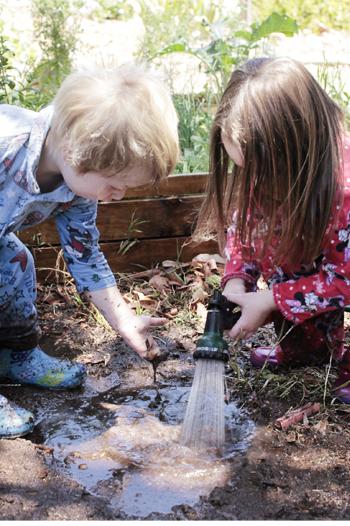Textured water play
Duration/age

Children often experiment with water. Gather some containers, tubes and funnels and help your child experiment with how the water flows from one container to the next. Together you can explore how much water one container will hold compared to another and how quickly a container will fill up before it flows over the top.
Adding different textures and natural resources such as sand, soil or bark chips to water play changes the play. Suddenly the water doesn’t flow as fast when you are pouring. It may not flow through all of the tubes, funnels and containers any more. Sometimes the sand or soil sticks at the bottom of the container when it becomes too dry and you have to dig it out. Will you need to change what you use to add texture to the water or can you experiment with mixing different quantities of water to the textures?
What happens if we pour the gooey mixture through the strainer?
If you add sand to the water, explore how to make sandcastles using the wet sloppy mess.
How can you make firmer mixture that can be shaped into a sandcastle? Can you do the same with a soil and water mixture? What happens to the water mix if you leave it outside in the sun for a while?
Materials you will need
- Spoon
- Water
- Small containers
- Plastic tubing
- Funnels
- Trays or shallow dishes
- Sand
- Dirt
- Small pebbles
- Bark chips
- Pasta strainers
Skills this activity improves
Why does this matter?
Experimenting with adding texture to water play helps children to develop problem-solving skills, develop motor skills and contributes to early language development.
Fine motor skills such as eye-hand coordination and hand and finger strength are developed as children hold, grasp and pour from one container to the next. As they grasp the containers and pour from one to the next they are exploring and experimenting with time, measurement, capacity and prediction. How much will one container hold compared to another and will the mixture flow through a small narrow opening or only a large wide one?
What does this lead to?
By experimenting with texture in water children are provided with the opportunity to share with others their knowledge of space, measurement and words that describe the texture and density of sand and soil in water. As children experiment they are learning that we can use different words and language to describe how we measure things and that this will change to reflect what we are measuring.
As they experiment they begin to predict what will happen to the water and whether the same things can be used or if different ones will need to be added. This is the beginning of problem-solving as children make predictions about an outcome and test out their theories.
Language to use
- Liquid, solid, density, lumpy, smooth
- Pour, strain, stir, scoop, dig
- Top, bottom, empty, full
- Capacity, volume, flow
- Dry, wet
Questions to use
- What happens to the water when you add sand?
- Can you still pour the water when you add a solid?
- Which one flows faster?
- What happens to the sand when you add water?
- What happens when you pour the water and sand through a strainer?
Useful tips
- You might also like to take a look at the activities Watering the garden.
- For safety information see Safety for children 0-4 years or visit www.parenting.sa.gov.au
- Remember to talk to your child in your home language.
More ideas
- Make mashed potato together.
- Make your own gooey gloop – 2 cups of water to one packet of cornflour.
- Make fruit smoothies.
Variation by age
Birth to two year olds
- Create a sand tray with funnels and sieves.
- Ask your child to help you fill the watering can and water the garden.
- Make a mud patch in the garden.
Three to five year olds
- Set jelly into containers that are all sorts of different shapes and sizes.
- Predict what happens to the water when you cook rice Will the water still be in the container or will it have gone? Where do you think it went?
- Add a bath bomb to the bath. What happens to the bomb?
Questions to ask
- Where does the sand go?
- What does it feel like?
- Where does the water go?
Questions to ask
- Where did the water go?
- What happened to the powder?
- Will it dissolve?
- Will it stay the same shape?
Language to use
- Top, bottom, full, empty, under
- Mix, dig, stir
- Up, down
Language to use
- Liquid, solid, set, firm
- Dissolve, absorb
- Volume, capacity, depth


